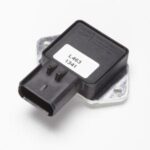Encountering a P0088 code in your Ford 6.4L diesel engine can be concerning. This diagnostic trouble code (DTC) indicates a “Fuel Rail/System Pressure – Too High,” and while it can stem from various issues, for Ford 6.4L diesel owners, there’s a crucial piece of information you need to know. If P0088 is the only code you’re seeing, it might point to a specific problem addressed by Ford themselves in a technical service bulletin.
Decoding P0088: High Fuel Pressure Explained
The P0088 code signals that the engine’s fuel pressure is exceeding the expected range. Modern diesel engines like the 6.4L Power Stroke rely on high-pressure fuel injection systems for optimal performance and efficiency. This system includes components like the High-Pressure Fuel Pump (HPFP), fuel rails, and various sensors and valves to regulate fuel pressure precisely.
One critical component within the HPFP is the Pressure Control Valve (PCV). The PCV’s job is to manage fuel pressure, preventing it from getting too high. However, in some Ford 6.4L diesel engines, a manufacturing defect could lead to a sticking PCV. This malfunction can cause the fuel pressure to spike, triggering the P0088 code and potentially affecting engine performance.
Ford TSB 11-4-22: The Official Guidance for P0088 and 6.4L Diesels
Ford issued Technical Service Bulletin (TSB) 11-4-22 to address this very issue. Specifically targeting 2008-2010 F-250 to F-550 Super Duty vehicles equipped with the 6.4L diesel, this TSB highlights a lack of power issue accompanied by an intermittent P0088 code. Ford pinpoints the sticking PCV in the HPFP as a likely culprit in these cases.
Symptoms to Watch For:
- DTC P0088: This is the primary indicator.
- Lack of Power: You might notice reduced engine performance, especially during moderate to heavy acceleration when the engine is at full operating temperature.
- Intermittent Code: The P0088 code might not be constantly present but appear sporadically.
Diagnosing and Repairing P0088 According to the TSB
According to TSB 11-4-22, the diagnostic procedure is straightforward if P0088 is the only DTC present.
Diagnostic Steps:
- Check for Other DTCs: Use a scan tool to read all continuous memory DTCs.
- P0088 Alone? Confirm that P0088 is the only code present.
- If No: The TSB procedure does not apply. Follow standard Powertrain Control/Emission Diagnostics (PC/ED) procedures to diagnose the issue.
- If Yes: Proceed to the repair outlined in the TSB.
The Recommended Solution: HPFP Replacement
Ford’s recommended action in TSB 11-4-22 is to replace the High Pressure Fuel Pump (HPP). This is because the sticking PCV is often internal to the HPFP, making replacement the most effective solution.
Key Steps After HPFP Replacement:
- Fuel Volume Control Valve (VCV) and Fuel Pressure Control Valve (PCV) Adaptive Learning Reset: After installing the new HPFP, it’s crucial to reset the adaptive learning parameters for both the VCV and PCV. This ensures the engine control system correctly adapts to the new pump. Refer to the PC/ED, Section 4, Hard Start/No Start Diagnostic Subroutines step 7 for the reset procedure.
Parts and Labor Information from TSB 11-4-22
The TSB also provides essential information for repair, including the necessary part and estimated labor times.
Part Information:
- Part Number: 8C3Z-9A543-B
- Part Name: High Pressure Fuel Pump
Labor Times (for Warranty/Dealer Coding):
| Operation Description | Time |
|---|---|
| 2008-2010 F-Super Duty 6.4L Regular Cab: Check DTCs and Replace the HPP (Includes Prior Approval, Cab Removal/Installation, and VCV/PCV Adaptive Learning Reset) | 8.9 Hrs |
| 2008-2010 F-Super Duty 6.4L Super and Crew Cab: Check DTCs and Replace the HPP (Includes Prior Approval, Cab Removal/Installation, and VCV/PCV Adaptive Learning Reset) | 9.1 Hrs |
Dealer Coding:
- Basic Part No.: 9A543
- Condition Code: 42
Conclusion: Addressing P0088 in Ford 6.4L Diesel Engines
If you’re facing a P0088 code on your 2008-2010 Ford 6.4L diesel, and it’s the only code present, TSB 11-4-22 strongly suggests investigating a potentially sticking PCV valve within your HPFP. Replacing the HPFP, as outlined in the TSB, is the recommended course of action to resolve this issue and restore your vehicle’s performance. Always ensure proper diagnosis and consider consulting a qualified mechanic to perform this repair, especially given the complexities of high-pressure fuel systems.
